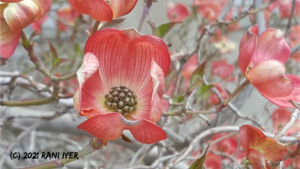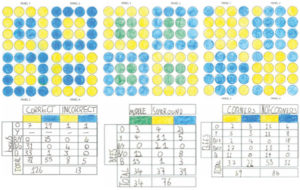Everyone has a favorite memory of the moon. Growing up in India when I was young, about 6-7 years old, I was not scared of the dark. Fear of the darkness came much later. The backyard in my grandfather’s place was a wonderland during the day and night. At night, I liked to watch the fireflies flashing their greenish-golden-whitish light. Sometimes, my aunt would point out to slender loris climbing down the trees. Bats swooped down on the mosquitoes buzzing over my head. The cows slumbered, and the world was quiet.
On days when we had a power outage, my grandmother entertained all of us. Sitting her children and grandchildren around her, she handed out balls of rice on our palms, sharing stories she had heard and enjoyed when she was a child. We pestered her to continue with the story, long after dinner, until every one of us fell asleep.
One full moon night, my uncle took me to the temple pond to take some pictures for the newspaper. The scent of jasmine, lotus, and herbs mingled with the lingering smell of sacred fire in the still night. But the most beautiful sight was the perfect reflection of a full moon in the calm pond. There was not a ripple. The moon seemed to float on the pond thrilling my young mind. On the way back, we encountered several bugs and animals I have never seen before. To me, the moon is the king of the night, shining into spaces that even the sun cannot penetrate.
When I read Hello, Moon by Julie Downing, I re-lived that night walk. The delightful verse book takes the young readers on a night walk in the streaming moonlight. Moonlight calls, come outside, as her verse invites the young readers to walk with her in the night. Her words beautifully capture the changing mood and the play of the light through the lives of the creatures. I am excited to present an interview with Julie Downing in this week’s blog. I received a copy of the book from Holiday House, enabling me to read the text closely.
Hello, Moon is an engaging picture book about day and night for young readers. What is your inspiration to write this book?
I have always been fascinated by the night and what happens while most people are asleep. I grew up in Colorado and often spent nights at my Grandparent’s cabin in the mountains. Sometimes, my cousins and I would stay awake late at night so we could watch all of the animals that came out after the sun set. Today, I am a city dweller, and I am still fascinated to see evidence of nocturnal animals in the city. About 2 years ago, I put a tiny lawn into my equally tiny backyard. Every morning, the lawn was dug up. I discovered that in the middle of the night, a family of raccoons was rolling back the sod so they could find slugs and insects for their dinner. Watching the raccoons, gave me the idea for Hello, Moon. For many animals, night is their day. Nocturnal animals wake up at dusk, play, eat, stay out of the rain and when the sun starts to rise, they snuggle in and fall asleep. Their routine is the same as a child’s day, it just happens at night.
The narrative of the book unfolds in verse. Did you always envision this as a book in verse?
I am still surprised that Hello, Moon is written in verse. I went back and forth with the text between rhyme and no rhyme. I think it is incredibly hard to write a rhyming picture book. The first version (well maybe 15th version) was prose. I showed it to my editor at Holiday House, and he said, “this book should really rhyme.” And of course, he was right! I wanted the book to be a reverse lullaby and the rhythm was important. I wrote and rewrote the words many times before the text felt right. I planned the story arc to highlight a forest between dusk and dawn and often rearranged my text, so it mirrored a child’s day from waking up to snuggling back into bed.
In this non-fiction, rhyming picture book, you have introduced tension, drama, emotions, and familiar comfort. All these must have taken a lot of thinking and revisions. Please share the journey of this manuscript from inception to publication.
Even though the text is only about 100 words, it took me a surprisingly long time to create Hello, Moon. The book started as a piece of sample artwork for a different book about twilight. I painted just the first spread with the morning glories and the house. That project did not work out, but I really liked my sample art. I used the art as a starting point and thought about all the activity that happens in a woodland forest at night. I illustrated a number of other books while I worked on Hello, Moon. I think there were at least 5 years between the piece of sample art and my final art for Hello, Moon.
The book went through a huge number of drafts while I tried to find the right approach. Nighttime is the opposite of daytime, so I played with the idea of each page highlighting opposite words such as up and down, or inside and outside. The more I worked on the text, the more I realized this concept limited me, so I decided to simplify the idea and just explore the opposite of day with a group of nocturnal animals. Even with a simple text, I still considered traditional storytelling elements. The story has rising action, a climatic thunderstorm, and a quiet resolution as all the animals fall asleep. One of the things I love about creating a picture books is how much of the story happens in the art. Most of the mood and drama for Hello, Moon happens in the pictures. I often alternate between writing and rewriting the text and sketching and revising the images in order to find the right balance between words and pictures.
The pictures in the book are bold, brilliant, with dark colors that induce the feeling of the dark setting. How did you research the environment? Did you have a particular ecosystem in mind when you wrote the book?
I did a lot of research as I explored where to set the book. I tried to walk a line between a specific place such as Northern California and an environment that felt universal. I spent a lot of time researching different animals that inhabit a woodland forest ecosystem. I learned about dens and nests and each animal’s nightly routine. I did have to think about how to portray predators and their prey. Small animals such as mice are often in danger, but ultimately this book is meant to be a comforting bedtime story, so the mice are “safe inside”.
What is the best way for teachers, parents, and homeschoolers to use this book in their lessons and classrooms?
There are many different ways to read and share Hello, Moon. To begin with, readers can follow the different animals and their offspring throughout the night. There is a limited cast of characters and the different animals appear in many different spreads.
The story arc mirrors a child’s day so children can also compare their daily routine with a nocturnal animal’s nightly routine. Teachers, parents, and children can talk about what is the same and what is different.
Readers can also compare how the landscape changes between dusk and dawn. Look carefully at the first spread and the last spread. The scene is the same, but there are many differences. When the moon rises in the first spread, the daytime #butterflies rest underneath leaves, the morning glories close their blooms, and a spider starts to weave its web. When the sun comes up in the final spread, the butterflies fill the sky, the flowers open up, and the spider has finished his web.
What is the most surprising thing you discovered while writing this book?
I always love the research part of any non-fiction project. I learned some interesting facts about lots of different nocturnal animals. I discovered that when it rains, moths hide under leaves or blades of grass, so they do not get wet. I also learned some wonderful facts that did not make it into the text. For example, I found out that every night a porcupine mother sings a lullaby to her babies so they will fall asleep. I ended up not putting a porcupine into this book, so I am going to save that fact for another book!

Please share your thoughts regarding how families and young readers can share this book to highlight the benefits of interacting with nature from a young age.
It is so important to be aware of the natural world around us. Appreciating nature helps children build a respect for our environment. I hope Hello, Moon allows young readers to see and understand the similarities between their daily life and the nightly routine of the animals in this book.
Any other information you wish to share with the readers.
I have always been a traditional watercolor painter and most of my picture books were created with watercolor and colored pencil. I love how controlled and uncontrolled watercolor can be. A few years ago, I started experimenting with combining digital and traditional mediums and the art for Hello, Moon was created this way. I painted all the elements in the illustrations using traditional watercolors and scanned them into the computer. The art is then combined digitally into the final paintings. This technique allows me to have the best of both worlds. I do lots of watercolor washes and paint trees, leaves and animals traditionally and then I can fine tune the color, make changes and play with other textures in Photoshop. One of the biggest advantages to this technique is the flexibility it gives me. If I make a mistake, I do not have to redo the art! It has been really fun to play with a new way of working.
Website and social media accounts you would like to share.
Website: www.juliedowning.com
Facebook: Julie Downing
Instagram: @juliedowning
What are you favorite memories about moonlight or full moon? Have you read this book? Please share your thoughts in response to this blog post. Have a wonderful moon time!






